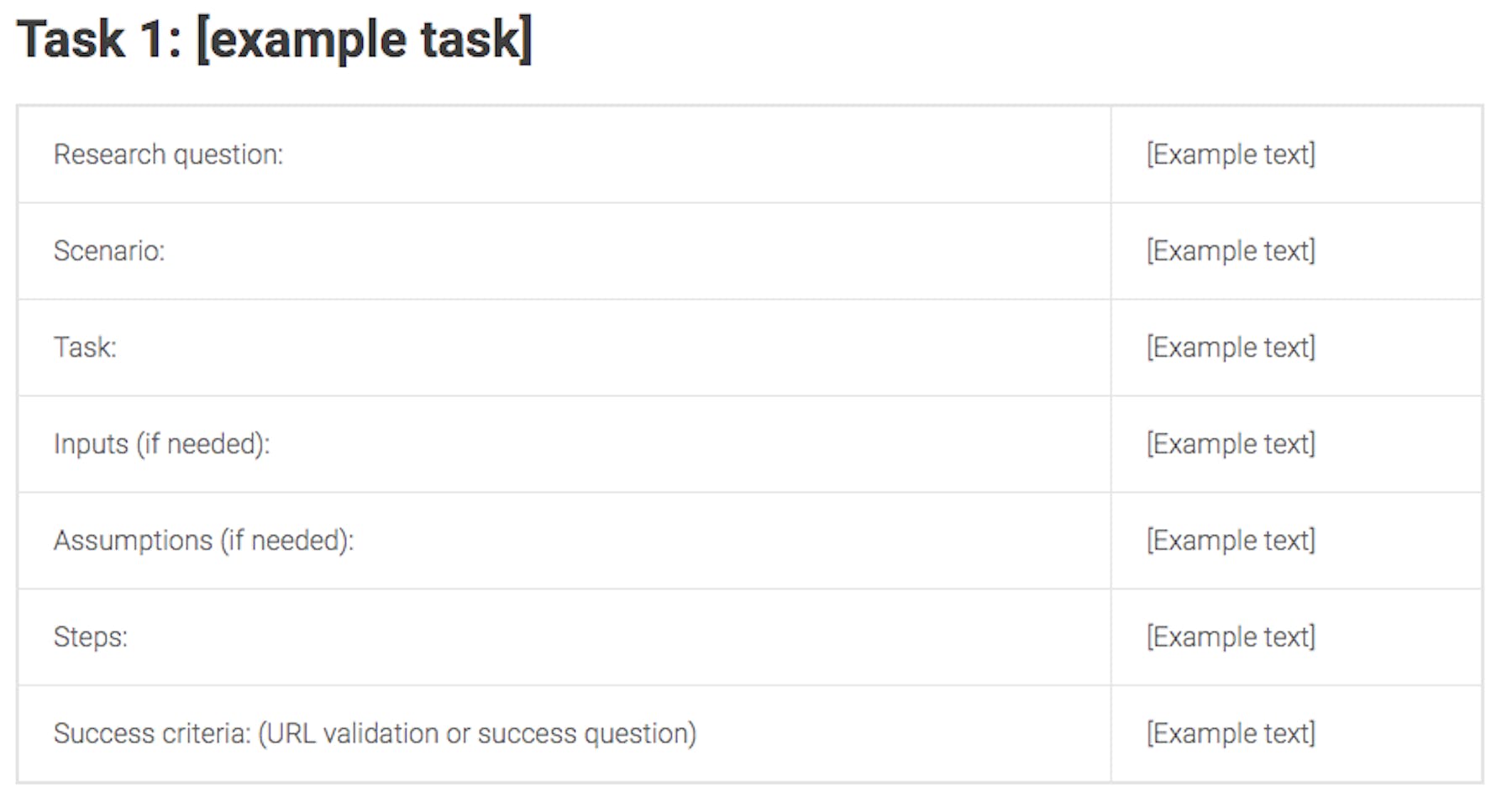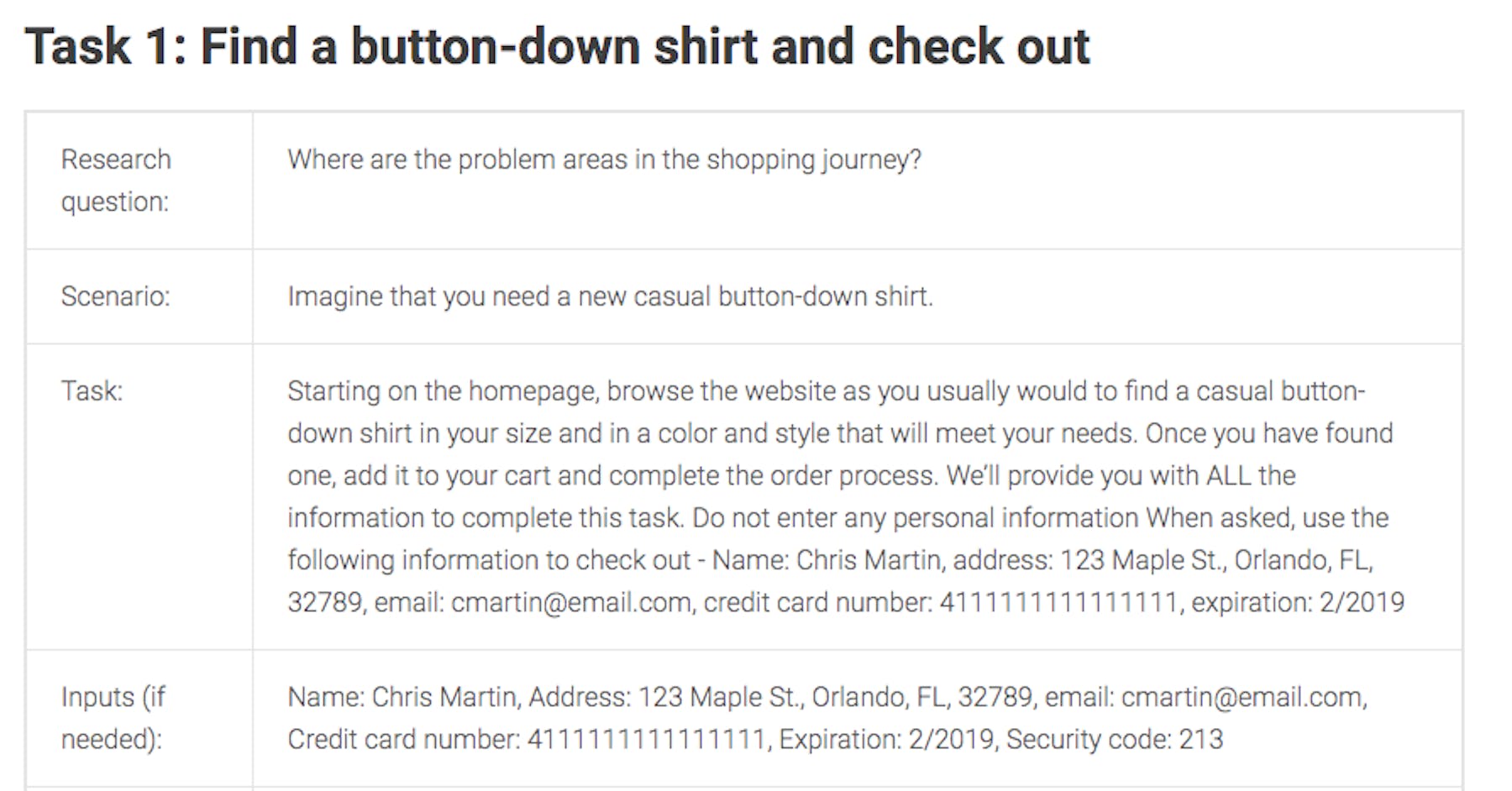
A simple template for writing usability tasks

Crafting tasks and scenarios for a usability study is a balancing act. In order to get realistic insights, you need to provide enough information so users aren’t guessing what they need to do, while also not providing too much information and biasing their chance of succeeding.
Whether your next research study is a moderated usability test or an unmoderated usability test, it’s important to clearly define what each task is and isn’t.
Often, your goal is to gather quantitative data about user behavior and interactions on your site, which is difficult and messy if there isn’t agreement upfront about the scenario, task and what you define as task success.
This is why a little forethought and a simple template is a great way for researchers and teams to get on the same page.
Planning your usability study
As a UX researcher, you’re going to run a lot of usability tests in your career. Sometimes you’ll be a domain expert and know exactly what is required of participants. Other times you won’t be knowledgeable about a particular product you're testing and may need some guidance to write the tasks.
In either case, having a usability testing template for writing usability tasks is a huge help.
Before you start working on the task details, make sure you have an agreed-upon scope or test plan which includes a clear definition of the overall studies purpose/objective, methodology, business/research objectives, and user research questions.
For example, a baseline test plan would look something like this:
- Study objective or purpose: Identify and improve UX and drive conversions on your key customer journeys.
- Methodology: Unmoderated Task-based study to be a maximum of 20 minutes in length
- Business objective: Understand how to improve your products
- Research objectives: Where are the problem areas in the shopping journey? Quantify those experiences so any changes are measurable in their impact - including QXscore
- Research questions: Can users complete key tasks?
It’s important to make sure you have clear research questions that will map to one or more of your tasks. These will guide what the analysis focuses on and how you report the results.
Ideally, the next step is to work with the stakeholders to develop or confirm the tasks. If you're not a domain expert, ask the stakeholder to walk you through the key tasks on their site or app, taking screenshots or recording the session (with their permission) to help further develop the tasks after the walkthrough.
To aid the process, we've developed a template that helps guide you through this task writing process and gives a framework to outline the scenarios and tasks to get you further, faster. It’s also a useful tool for helping stakeholders communicate and achieve buy-in from the product team.
Template for writing usability tasks
The template below outlines tasks and scenarios. It's can be shared with customers or stakeholders if researchers won't be personally writing the tasks.
You shouldn't expect them to get it exactly right, but it has all the elements necessary to provide them with a better understanding of the task goal, assumptions, steps, and success criteria so that you can get a game plan developed together.
Make one copy of this table for each task you create:

Here's an example of a pre-filled task template

Instructions for use
Task # and name: Give each task a brief descriptive name and a number. The name helps you remember what its purpose is, and the numbers are useful in usability testing because you can ask the observers things such as, “Shall we skip 3 this time and go right to 4?” without discussing the content of the tasks in front of the users.
Research question: What will users have accomplished when they’re done with the task? Is there a tangible output? How will they know the task is complete? What might the users do to be sure?
Inputs: List all the information or resources (tangible and intangible) that a user would need to complete this task. Examples include: a valid login, business policies, physical objects such as a textbook, or a credit card, file names, and so on. Real users may have some of this information in their heads—in your usability task, you might have to provide this information.
Assumptions: These are the conditions and prerequisites that are in place at the start of the task. The assumptions depend on what you want to learn from the task.
Steps: Write down the steps you expect the user will go through in completing the task. This helps you identify the inputs and assumptions that you’ll need to create. Writing down the expected steps can also be helpful if there will be observers who aren’t as familiar with the interface as you are. Keep the steps mostly at a screen level—no need to list every field on the order form, just say, “Order form.” Some tasks have multiple paths that lead to success, so jot down any variations, such as “Search OR navigate to lawn & garden page.” Optional steps can be noted in parentheses (e.g., review privacy policy).
Success criteria: Specific measurable criteria for determining that the task was successfully completed. For example, a URL or snippet of URL (e.g., thankyou.html), or a Success question (e.g., “What was the cost of the quoted insurance policy?” A) $125.00 (success), B) $150.00, C) $300.00, D) $110.00)
Notes: The notes section might have several types of information, including the reasons why you created the task, how you’ll conduct it, specific things to watch for, and questions to ask users after the task is complete. Information to include in the notes varies depending on what’s being tested. Write down whatever information you think will be useful to have on hand during the usability tests, and give copies of the completed task templates to usability test observers.
Conclusion
Whether you’re working with stakeholders to develop tasks or working on them yourself, this handy template is a great way to organize your thoughts and make sure you’re prepping for a successful study.
Related reading: Usability testing examples


